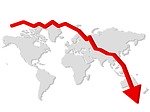
Most investors would like to forget March 2020.
Times of uncertainty and market stress, however, have reinforced three investing fundamentals.
Remembering these fundamentals will help keep your investment goals on track.
1. Vast uncertainty causes dramatic and quick stock price movements.
For the 12 months prior to March 2020, the US stock market, as measured by the Vanguard Total Stock Market Index Fund (VTSAX), had only a handful of days in which prices fluctuated more than one percent. This period was relatively calm.
March 2020 was the opposite. There were only three days in which the Vanguard Total Stock Market Index Fund didn’t fluctuate at least two percent. In fact, there were some pretty dramatic swings.
- Thursday, March 12 – 9.7 percent drop
- Friday, March 13 – 9.0 percent gain
- Monday, March 16 – 12.3 percent drop
- Tuesday, March 17 – 5.8 percent gain
- Wednesday, March 18 – 5.9 percent drop
According to Morningstar, leveraged investors, such as hedge funds, intensified the rapid pace of price declines, by switching from selling what they wanted to sell to selling what they could sell. These speculators’ sales were driven by the need to raise enough cash by the market close to cover margins (the amount of borrowed money). And the decline in oil prices caused by a combination of lower demand and an oil price war between Russia and Saudi Arabia exacerbated the trend.
In times like these, average investors should not do anything sudden. Despite these dramatic swings, stock prices are about where they were in early 2019.
And keep in mind that over the long-term, stocks have risen at least 6 percent per year over any 20-year rolling period no matter when you invested (even at a high point). In many 20-year periods, they have gained up to 17 percent.
So, if your time horizon is long, then stocks are still the place to be. Try not to worry about the volatility day-to-day or year-to-year.
2. A diversified portfolio containing different asset classes, such as stocks and bonds, can help mute the volatility of any single investment.
While the Vanguard Total Stock Market Index Fund (VTSAX) lost 20 percent of its value since January 1, 2020, the bond market – as measured by the Vanguard Total Bond Market Index Fund (VBTLX) – has risen three percent. While not a perfect correlation, they do tend to move in opposite directions.
And the Vanguard Total Bond Market Index Fund has been less volatile than the Total Stock Fund. There were only three days in March in which its price moved more than one percent.
Bonds and other fixed income assets are a haven – the ballast for your stocks so to speak – of a diversified stock portfolio.
3. Time to rebalance to your target asset allocation.
Asset allocation – the allocation between stocks and bonds — is the single most important decision that you can make to influence the portfolio’s return. A greater stock allocation has historically meant a greater return but with more volatility.
Market timing has historically proven to be very difficult to execute on a consistent basis. Its nearly impossible to gain more than the market over time. Research shows that it is necessary to be in all asset classes (e.g., large stocks, emerging markets, fixed income, etc.) all of the time to guard against ill-timing.
With that said, it may be time to look at your stock / bond allocation to see if it is out of balance. An often-cited rule of thumb to rebalance is when the account’s asset allocation has moved more than three percent out of balance. Your bond allocation could be more than your target bond allocation because of recent stock price declines. Now would be the time to sell some of the bond funds and use the proceeds to purchase stock funds.
In sum, stock market investing is a long-term strategy that can be made less volatile by using a well-diversified portfolio.

No comments yet.